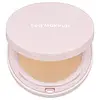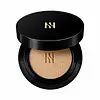What's inside
What's inside
 Key Ingredients
Key Ingredients

 Benefits
Benefits

 Concerns
Concerns

 Ingredients Side-by-side
Ingredients Side-by-side

Talc
AbrasiveTriethoxycaprylylsilane
Mica
Cosmetic ColorantPolyethylene
AbrasiveDimethicone
EmollientTridecyl Trimellitate
EmollientMagnesium Stearate
Cosmetic ColorantEthylhexyl Palmitate
EmollientSalicylic Acid
MaskingCeramide NP
Skin ConditioningNiacinamide
SmoothingC12-15 Alkyl Benzoate
AntimicrobialTocopheryl Acetate
AntioxidantUbiquinone
AntioxidantCarthamus Tinctorius Extract
EmollientHouttuynia Cordata Extract
Skin ConditioningCentella Asiatica Extract
CleansingCamellia Sinensis Leaf Extract
AntimicrobialPhenoxyethanol
Preservative1,2-Hexanediol
Skin ConditioningEthylhexylglycerin
Skin ConditioningCI 77891
Cosmetic ColorantCI 77492
Cosmetic ColorantCI 77491
Cosmetic ColorantCI 77499
Cosmetic ColorantTalc, Triethoxycaprylylsilane, Mica, Polyethylene, Dimethicone, Tridecyl Trimellitate, Magnesium Stearate, Ethylhexyl Palmitate, Salicylic Acid, Ceramide NP, Niacinamide, C12-15 Alkyl Benzoate, Tocopheryl Acetate, Ubiquinone, Carthamus Tinctorius Extract, Houttuynia Cordata Extract, Centella Asiatica Extract, Camellia Sinensis Leaf Extract, Phenoxyethanol, 1,2-Hexanediol, Ethylhexylglycerin, CI 77891, CI 77492, CI 77491, CI 77499
Water
Skin ConditioningCyclopentasiloxane
EmollientMethyl Trimethicone
Skin ConditioningButylene Glycol
HumectantEthylhexyl Methoxycinnamate
UV AbsorberCI 77891
Cosmetic ColorantMica
Cosmetic ColorantCyclohexasiloxane
EmollientTrimethylsiloxysilicate
EmollientPEG-10 Dimethicone
Skin ConditioningDisteardimonium Hectorite
StabilisingCI 77947
Methyl Methacrylate Crosspolymer
Lauryl PEG-9 Polydimethylsiloxyethyl Dimethicone
Skin ConditioningDimethicone
EmollientCI 77492
Cosmetic ColorantAcrylates/Ethylhexyl Acrylate/Dimethicone Methacrylate Copolymer
Skin ConditioningAcrylates/Stearyl Acrylate/Dimethicone Methacrylate Copolymer
Sodium Chloride
MaskingAluminum Hydroxide
EmollientGlycerin
HumectantParfum
MaskingCI 77491
Cosmetic ColorantPolysorbate 40
EmulsifyingPolysilicone-11
Polysorbate 80
EmulsifyingCaprylyl Glycol
EmollientTriethoxycaprylylsilane
Lauroyl Lysine
Skin ConditioningStearic Acid
CleansingHydrogenated Lecithin
EmulsifyingPolyhydroxystearic Acid
EmulsifyingEthylhexylglycerin
Skin ConditioningCI 77499
Cosmetic ColorantDisodium EDTA
Lecithin
EmollientEthylhexyl Palmitate
EmollientIsostearic Acid
CleansingIsopropyl Palmitate
EmollientPolyglyceryl-3 Polyricinoleate
EmulsifyingWater, Cyclopentasiloxane, Methyl Trimethicone, Butylene Glycol, Ethylhexyl Methoxycinnamate, CI 77891, Mica, Cyclohexasiloxane, Trimethylsiloxysilicate, PEG-10 Dimethicone, Disteardimonium Hectorite, CI 77947, Methyl Methacrylate Crosspolymer, Lauryl PEG-9 Polydimethylsiloxyethyl Dimethicone, Dimethicone, CI 77492, Acrylates/Ethylhexyl Acrylate/Dimethicone Methacrylate Copolymer, Acrylates/Stearyl Acrylate/Dimethicone Methacrylate Copolymer, Sodium Chloride, Aluminum Hydroxide, Glycerin, Parfum, CI 77491, Polysorbate 40, Polysilicone-11, Polysorbate 80, Caprylyl Glycol, Triethoxycaprylylsilane, Lauroyl Lysine, Stearic Acid, Hydrogenated Lecithin, Polyhydroxystearic Acid, Ethylhexylglycerin, CI 77499, Disodium EDTA, Lecithin, Ethylhexyl Palmitate, Isostearic Acid, Isopropyl Palmitate, Polyglyceryl-3 Polyricinoleate
Ingredients Explained
These ingredients are found in both products.
Ingredients higher up in an ingredient list are typically present in a larger amount.
Ci 77491 is also hydrated iron III oxide. It's sole purpose is to give a red/pink hue to products.
Iron III oxides are classified as inorganic chemicals for coloring.
Synthetically created Ci 77491 is considered safer than those naturally found. This is because the synthetically created version may contain less impurities. Iron oxides are generally non-toxic and non-allergenic.
Learn more about CI 77491Ci 77492 is also hydrated iron III oxide. It's sole purpose is to give a yellow hue to products.
Iron III oxides are classified as inorganic chemicals for coloring.
Synthetically created Ci 77492 is considered safer than those naturally found. This is because the synthetically created version may contain less impurities. Iron oxides are generally non-toxic and non-allergenic.
Learn more about CI 77492Ci 77499 is also hydrated iron III oxide. It is created from mixing red and black iron oxides. This helps give shades of darkness to a product.
Iron III oxides are classified as inorganic chemicals for coloring.
Ci 77891 is a white pigment from Titanium dioxide. It is naturally found in minerals such as rutile and ilmenite.
It's main function is to add a white color to cosmetics. It can also be mixed with other colors to create different shades.
Ci 77891 is commonly found in sunscreens due to its ability to block UV rays.
Learn more about CI 77891Dimethicone is a type of synthetic silicone created from natural materials such as quartz.
What it does:
Dimethicone comes in different viscosities:
Depending on the viscosity, dimethicone has different properties.
Ingredients lists don't always show which type is used, so we recommend reaching out to the brand if you have questions about the viscosity.
This ingredient is unlikely to cause irritation because it does not get absorbed into skin. However, people with silicone allergies should be careful about using this ingredient.
Note: Dimethicone may contribute to pilling. This is because it is not oil or water soluble, so pilling may occur when layered with products. When mixed with heavy oils in a formula, the outcome is also quite greasy.
Learn more about DimethiconeEthylhexyl Palmitate, also known as octyl palmitate, is created from 2-ethylhexyl alcohol and palmitic acid. It is a fatty acid ester.
The fatty acid content of Ethylhexyl Palmitate makes it an emollient. Emollients help soften and hydrate your skin by trapping moisture within.
Ethylhexyl Palmitate is also used to help improve the texture of cosmetics. It helps other ingredient dissolve in products and help disperse ingredients more evenly.
You'll likely find this ingredient in sunscreen, as it is often used to mix UV-blocking ingredients such as avobenzone and ethylhexyl triazone.
It can also help stabilize the fragrances in a product as a fragrance fixative.
Ethylhexyl Palmitate can be used to substitute mineral oil.
Due to its high fatty acid content, it may not be fungal-acne safe.
Learn more about Ethylhexyl PalmitateEthylhexylglycerin (we can't pronounce this either) is commonly used as a preservative and skin softener. It is derived from glyceryl.
You might see Ethylhexylglycerin often paired with other preservatives such as phenoxyethanol. Ethylhexylglycerin has been found to increase the effectiveness of these other preservatives.
Mica is a naturally occurring mineral used to add shimmer and color in cosmetics. It can also help improve the texture of a product or give it an opaque, white/silver color.
Serecite is the name for very fine but ragged grains of mica.
This ingredient is often coated with metal oxides like titanium dioxide. Trace amounts of heavy metals may be found in mica, but these metals are not harmful in our personal products.
Mica has been used since prehistoric times throughout the world. Ancient Egyptian, Indian, Greek, Roman, Aztec, and Chinese civilizations have used mica.
Learn more about MicaTriethoxycaprylylsilane is a silicone used to bind and stabilize ingredients.
As an emulsifier, it helps prevent ingredients from separating. This can help elongate the shelf life of products.
Triethoxycaprylylsilane is often used to coat mineral sunscreens ingredients to help give a better feel. It also helps reduce oxidative stress in sunscreens.
Learn more about Triethoxycaprylylsilane